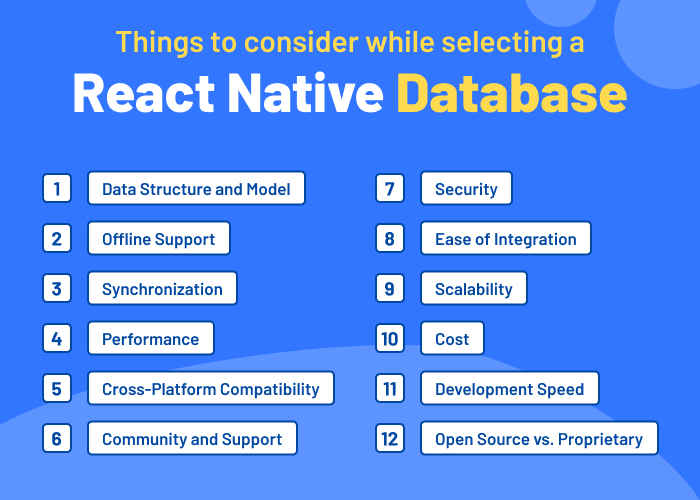Things to consider while selecting a React Native database

When choosing React Native databases, keep the following important considerations in mind:
- Data Structure and Model: Consider the data structure and model of your application. Different databases are optimized for specific data structures, such as relational, document-oriented, or key-value.
- Offline Support: If your app needs to work offline or in poor network conditions, consider databases that offer robust offline support.
- Synchronization: Ensure that the selected database supports data synchronization between the local device and the server.
- Performance: Evaluate the performance of the database under different conditions.
- Cross-Platform Compatibility: If you are developing a cross-platform app using React Native, make sure the database is compatible with both iOS and Android platforms.
- Community and Support: Choose a database with an active community and good developer support.
- Security: Security is paramount, especially when dealing with sensitive user data. Ensure that the selected database provides features such as encryption, access controls, and other security measures.
- Ease of Integration: Consider the ease of integration with React Native. Some databases offer official React Native libraries or community-supported plugins, making integration smoother.
- Scalability: Choose a database that can scale with your app’s increasing data and user base without compromising performance.
- Cost: Understand the pricing model of the database, including any upfront costs, ongoing fees, or limitations on usage.
- Development Speed: Some databases may offer features that speed up development, such as easy setup, automatic schema generation, and intuitive APIs. Consider these factors, especially if you are working with tight deadlines.
- Open Source vs. Proprietary: Consider whether you prefer open-source databases or are willing to use proprietary solutions.
Best React Native databases for your project
SQLite
For the development of your React Native application, are you seeking a well-designed and grounded database? That would be the SQLite. It is a relational database management system (RDMS) designed to meet the storage needs of mobile applications. SQLite doesn’t require a separate server and lets you write the data straight into multiple files. But in many circumstances, SQLite has a size restriction of up to 2GB. Furthermore, the drawback of SQLite is that it manages HTTP requests with low to medium traffic.
Firebase
NoSQL databases are supported by Firebase, which is owned by Google. React Native projects with MVC architecture that need a large database can be managed by it. Additionally, Firebase is the best option if you want to create an app that needs synchronization and offline data updates.
Additionally, it includes a performance tracking tool to assist you in finding flaws in your application, and you can always delete data from the Google server. It is ideally suited for the banking and financial sectors because of its high level of compliance with SOX rules.
All clients simultaneously get real-time data synchronization when using Firebase for the React Native database. This becomes crucial in situations where an app unexpectedly stops working due to a lack of internet connectivity. Additionally, since the data may be accessed directly through a mobile device, you won’t require an application server to access it. Real-time apps with offline persistence features may be created by developers using Firebase and React Native together. This includes recording the timestamp each time a user disconnects and indicating whether they are online or not.
Realm
Operating at a speed ten times faster than a relational database is The Realm React Native database. It also supports complex data types for offline and real-time applications. It has its own search engine and doesn’t require any object-related mapping or key-value storage. Multiple sources or threads can access the items stored in the Realm database.
When working with large amounts of data, developers choose to use the Realm database to enhance the speed of a React Native application. Compared to SQLite and other databases, Realm has demonstrated superior query correction due to its fast performance. Overall, this database is excellent and the greatest option for apps with a lot of data.
PouchDB
This is a JSON-formatted, open-source, React Native database. It provides a simple JavaScript API that lets users create, read, and change data. For continuous processing of data, all it takes to access the other available API on the react native platform is just one call.
Users can synchronize several data at once with this database. Multiple clients cannot be in sync with each other when using any native library other than OS. Furthermore, peer-to-peer replication enables the server-side local storage to be disconnected while both copies are being updated simultaneously. Following the upgrade, there is no data leakage as the data is synchronized across several clients.
WatermelonDB
WatermelonDB is a database with exceptional speed. It can expand from hundreds to thousands of records while remaining dependable and fast. It is well-optimized for creating complex React Native apps. On low-end devices, it constantly manages data. It won’t load any extraneous data until you specifically ask it to.
Conclusion
Selecting the best React Native database is a crucial decision that depends on various factors, including the specific requirements of your application, scalability needs, and familiarity with different technologies. While there is no one-size-fits-all answer, several databases stand out in the React Native ecosystem, each offering unique features and advantages.
FAQs
What factors should I consider when choosing a React Native database?
Are Firebase Realtime Database and Firestore suitable for all projects?
Is SQLite a good choice for the React Native database?
How does Realm differ from other React Native databases?
Can I use multiple databases in a React Native project?
Ravi Bhojani is the Chief Marketing Officer (CMO) at Alian Software, where he spearheads the company’s marketing strategies and drives its brand presence in the competitive IT services landscape. With over a decade of experience in the technology and marketing sectors, Ravi has consistently demonstrated his ability to blend innovative marketing techniques with deep industry knowledge to deliver outstanding results.